Rasterization,
Hidden Surface Removal
and
OpenGL Buffers
Speaker : 羅右鈞
Date : 2015.8.4
Location : 交通大學
Rasterization
- Or called Scan conversion
- Convert primitives to fragments (potential pixels)
- We will focus on how to do line drawing and polygon filling

Rasterization
Line drawing
- DDA
- Bresenham's Algorithm
Polygon filling
- Flood Fill
DDA (Digital Differential Analyzer)
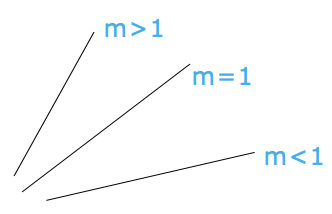
- Simplest line drawing algorithm
- Basic idea :
using precalculated slope m by two given endpoints, and
when m >= 1 : increment x by 1, find the best y in each iteration
when m < 1 : increment y by 1, find the best x in each iteration
(we ignore negative slope)
DDA (Digital Differential Analyzer)
Assume write_pixel (int x, int y, int color) .
given two endpoints (x1, y1) , (x2, y2) ,
we can get the slope :
m = (y2 - y1) / (x2 - x1)
=> m = △y / △x
=> △y = m△x
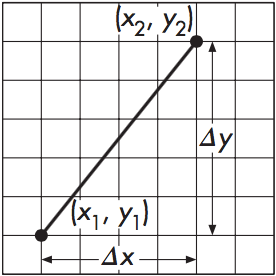
DDA (Digital Differential Analyzer)
Assume 0 <= m <= 1,
we increment x by 1, find the best y in each iteration :
for ( x = x1 ; x <= x2 ; x++ ) {
y += m;
write_pixel ( x, round(y), color ); // 由於 m 可能是浮點數,需對y做四捨五入找出最適當的pixel位置
}
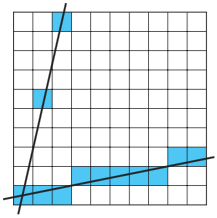
then we get the result :
DDA (Digital Differential Analyzer)
The result is not good enough when m > 1,
so when m > 1, we need to change our method to
increment y by 1, find the best x in each iteration.

(not optimized)
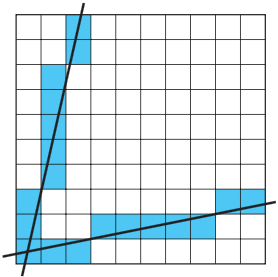
(optimized)
Bresenham's Algorithm
Optimized DDA algorithm (avoid floating-point operation) .
Given two endpoints (x0, y0) , (x1, y1) , assume :
- x1 > x0
- line equation : y = mx + b
- 0 <= m <= 1, where m is slope
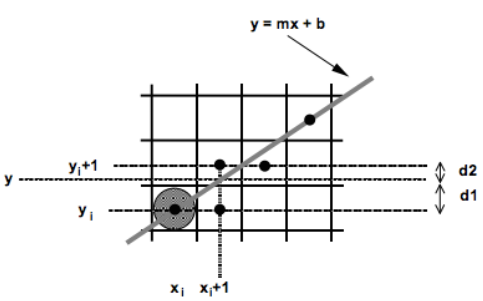
Bresenham's Algorithm
In this case, we increment x by 1 and find the best y, just same as DDA .
Assume we currently finish processing the pixel (xi, yi) .
We want to find the next position of pixel (xi+1, yi+1) .
xi+1 = xi + 1, since we increment x by 1.
we need to determine y = yi or yi + 1 (remain y or increment y by 1) .

Bresenham's Algorithm

Define :
- d1 = y - yi
- d2 = (yi + 1) - y
Since y = m(xi + 1) + b when x = xi + 1 (by y = mx + b) ,
we get :
- d1 = m(xi + 1) + b - yi
- d2 = (yi + 1) - m(xi + 1) - b
d1 - d2 = m(xi + 1) + b - yi - yi - 1 + m(xi + 1) + b
= 2m(xi + 1) - 2yi + 2b - 1
Bresenham's Algorithm

How to determine yi+1 ?
When d1 - d2 < 0 , yi+1 = yi (remain y)
When d1 - d2 > 0 , yi+1 = yi + 1 (increment y by 1)
Bresenham's Algorithm
How to avoid floating-point operation ?
We simply multiply △x to m = △y /△x to eliminate denominator.
We apply this to d1 - d2 = 2m(xi + 1) - 2yi + 2b - 1 :
Assume pi = △x (d1 - d2)
= △x [ 2m( xi + 1 ) - 2yi + 2b - 1 ]
= △x [ 2・(△y / △x)・( xi + 1 ) - 2yi + 2b - 1 ] ( by m = △y / △x )
= 2△y ( xi + 1 ) - 2△x・yi + 2△x・b - △x ( by multiplying △x )
= 2△y・xi + 2△y - 2△x・yi + 2△x・b - △x
= 2△y・xi - 2△x・yi + 2△y + 2△x・b - △x
The blue part is constant in every iteration, we can simplify as
pi = 2△y・xi - 2△x・yi + c
Bresenham's Algorithm
Since determine d1 - d2 is positive or negative to pick the best y
= determine pi is positive or negative
pi = 2△y・xi - 2△x・yi + c
pi+1 = 2△y・xi+1 - 2△x・yi+1 + c
pi+1 - pi
= 2△y・xi+1 - 2△x・yi+1 + c - (2△y・xi - 2△x・yi + c)
= 2△y・(xi+1 - xi) - 2△x・(yi+1 - yi) ( xi+1 - xi = 1, since we increment x by 1)
= 2△y - 2△x・(yi+1 - yi)
Finally we get pi+1 = pi + 2△y - 2△x・(yi+1 - yi)
The blue part is either 0 (pi < 0) or 1(pi > 0)
Bresenham's Algorithm
In conclusion :
- when pi < 0 , pi+1 = pi + 2△y , since yi+1 - yi = 0
- when pi > 0 , pi+1 = pi + 2△y - 2△x , since yi+1 - yi = 1
So we only need to calculate the initial p ,
then in every iteration , we calculate next p by the below formula to
determine the next pixel position ( find the best y ) .
we know that pi = 2△y・xi - 2△x・yi + 2△y + 2△x・b - △x
p0 (initial p)
= 2△y・x0 - 2△x・y0 + 2△y + 2△x・b - △x
= 2△y・x0 - 2△x・y0 + 2△y + 2△x・[ y0 - (△y / △x)・x0 ] - △x
( by y0 = m・x0 + b => b = y0 - (△y / △x)・x0 )
= 2△y - 2△x
Bresenham's Algorithm
So, this is how it works :
1. given two endpoints (x0, y0) , (x1, y1)
2. calculate constants :
- △x = x1 - x0 and △y = y1 - y0
- 2△x and 2△y
- p0 = 2△y - 2△x
3. draw pixel ( round(x0), round(y0) )
4. for x = x0 to x1, i = 0 {
if ( pi < 0 ) , write_pixel (xi + 1, yi, color) , pi+1 = pi + 2△y
else , write_pixel (xi + 1, yi + 1, color) , pi+1 = pi + 2△y - 2△x
increment i
}
Polygon Rasterization
Hollow polygon :
use Bresenham's algorithm or another line drawing algorithm to draw polygon's edges.
Solid polygon :
use Flood Fill algorithm.
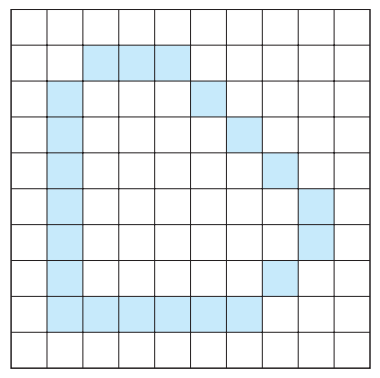
Flood Fill Algorithm
First find the initial point (x,y) (or called seed point) ,
then recursively find the neighbors of the seed point and draw them.
Assume we have a function read_pixel (x, y) to get the pixel color at the position (x, y)
void flood_fill(int x, int y) {
if ( read_pixel(x,y) == replacement_color ) {
write_pixel(x,y,target_color);
flood_fill(x-1,y);
flood_fill(x+1,y);
flood_fill(x,y-1);
flood_fill(x,y+1);
}
}Hidden Surface Removal
- or called visible-surface determination
- determine which fragments are visible
- two approachs :
- Object space approach , such as Painter algorithm.
- Image space approach , such as Z-buffer algorithm.
Painter Algorithm
- Or called Priority Fill
- Sort objects depending on their distance to viewer, then draw them from far to near. But whenever object or camera moves, we need to sort again.
- Not work in this case :
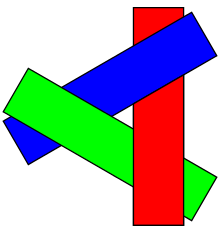
Z-buffer Algorithm
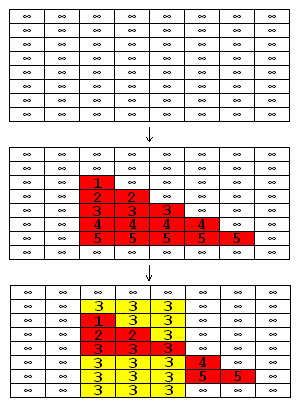
OpenGL Buffers
Frame buffer consists of :
- Color buffer
- Depth buffer
- Stencil buffer
- Accumulation buffer
Color Buffer
- Color buffer consists of :
- Front buffer
- Back buffer
- Save pixel's RGB or RGBA values
( need to set glutInitDisplayMode( GLUT_RGBA ) )
Single buffering
- Set glutInitDisplayMode(GLUT_SINGLE)
- Only use front buffer for display and rendering
- Problem : monitor refreshing and GPU drawing are asynchronized.
Could cause flickering when doing animation.
Double buffering
- Set glutInitDisplayMode(GLUT_DOUBLE)
- Use front buffer for display and back buffer for rendering
- Need to call glutSwapBuffers() in the end of display function
- Also remember to call glClear(GL_COLOR_BUFFER_BIT) to clear the previous drawing
Depth buffer (Z-buffer)
- Save pixel's depth value
- Need to do in OpenGL :
- glutInitDisplayMode(GLUT_DEPTH)
- glEnable(GL_DEPTH_TEST)
- Use glDepthFunc(GLenum func) to determine how to test depth value.
- Also remember to call glClear(GL_DEPTH_BUFFER_BIT) in the end of display function to clear the previous depth value
Depth buffer (Z-buffer)
(Cont.) Use glDepthFunc(GLenum func) to determine how to test depth value.
GL_NEVER:never pass
GL_LESS:if target pixel's z value < current pixel's z value,then pass (default)
GL_EQUAL:if target pixel's z value = current pixel's z value,then pass
GL_LEQUAL:if target pixel's z value <= current pixel's z value,then pass
GL_GREATER :if target pixel's z value > current pixel's z value,then pass
GL_NOTEQUAL:if target pixel's z value != current pixel's z value,then pass
GL_GEQUAL:if target pixel's z value = current pixel's z value,then pass
GL_ALWAYS:always pass
Stencil buffer
- Provide programmer to save extra value in each pixel for customizing.
- Typicall applications : masking and inverted image

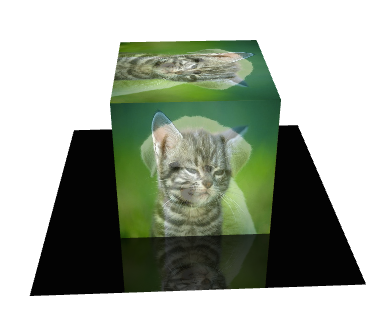
Accumulation buffer
- Save RGBA color components
- How many bits need to save each color component depend on hardware implementation. You can check it by calling glGetIntegerv
- Use glAccum( GLenum op, GLfloat value ) to manipulate accumulation buffer
Accumulation buffer
- (Cont.) Use glAccum( GLenum op, GLfloat value ) to manipulate accumulation buffer
op can be one of the following values:
GL_ACCUM:從目前選定的color buffer(front 或 back)中讀取值(用glReadBuffer(GL_FRONT 或 GL_BACK) 進行讀取而選定目前的color buffer)用給定的value乘上R、G、B、A值,然後將結果加到accumulation buffer 中。
GL_LOAD:跟GL_ACCUM操作類似,但它是用結果值替換掉accumulation buffer中的值,而不是與之相加。
GL_RETURN:從accumulation buffer中取值,以value乘以該值,然後將該結果放入目前選定的color buffer中。
GL_ADD:將value與accumulation中的每個pixel的R、G、B、A分量相加。
GL_MULT:將value與accumulation中的每個pixel的R、G、B、A分量相乘。
Accumulation buffer
- Typical applications : Motion blur and Anti-aliasing
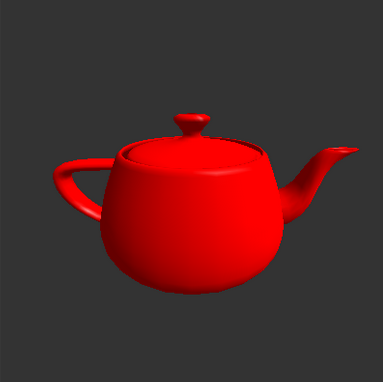
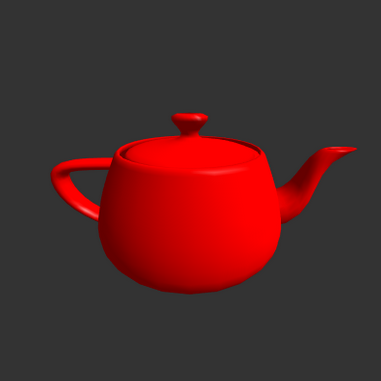
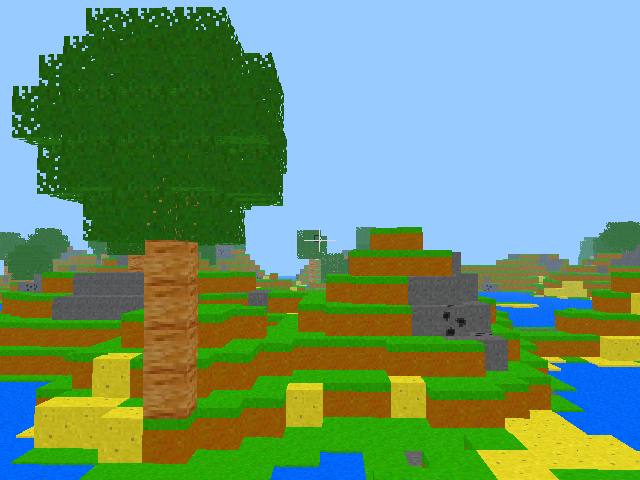
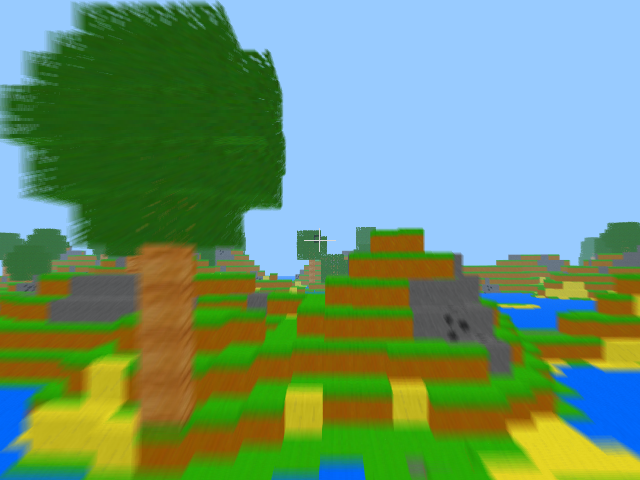
Without motion blur
With motion blur
Without anti-aliasing
With anti-aliasing
Rasterization, Hidden Surface Removal and OpenGL Buffers
By Howard Lo
Rasterization, Hidden Surface Removal and OpenGL Buffers
- 919



